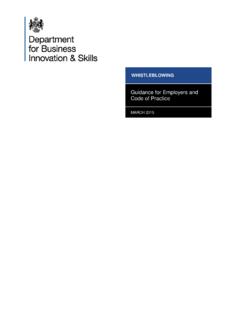Transcription of INTERNAL INVESTIGATION CHECKLIST
1 INTERNAL INVESTIGATION CHECKLIST . Revised November 2016. This publication is available at online at [This page is intentionally blank.]. Table of Contents Page Preface .. 1. I. Notice of Potential Harassment or Other Misconduct .. 1. II. Establishing Policies for Preventing Harassment and Conducting Investigations .. 2. III. Commencing the INVESTIGATION .. 3. A. Obtain Background Information on the Complainant and the Accused .. 4. B. Analyze the Complaint .. 4. C. Prepare for the 4. D. Do's and Don'ts .. 6. IV. The Interviews .. 8. A. Interviewing the Complainant .. 9. 1. Preliminary Issues to Discuss with the Complainant .. 9. 2. Investigating the 9. 3. Do's and Don'ts .. 12. B. Interviewing the Accused .. 12. 1. Preliminary Issues to Discuss with the Accused .. 12. 2. Investigating the 13. 3. Do's and Don'ts .. 15.
2 C. Interviewing the Witnesses .. 16. 1. Preliminary Issues to Discuss with the Witness .. 16. 2. Investigating the 17. 3. Uncooperative 18. 4. Do's and Don'ts .. 19. D. Re-Interview the Parties or the Witnesses if Necessary .. 20. V. Summarizing the Results of the INVESTIGATION .. 20. A. Analyzing the INVESTIGATION .. 20. B. Making a Determination Regarding the Merits of the 21. C. Deciding Corrective and/or Disciplinary Action .. 22. D. Prepare the Investigative Report .. 24. E. Prepare the Investigative File .. 25. F. Discussing the Results of the INVESTIGATION .. 26. G. After the INVESTIGATION Is Completed .. 26. H. Do's and Don'ts .. 27. VI. Recap: 10 Most Costly Mistakes .. 27. ii INTERNAL INVESTIGATION CHECKLIST Preface Employers are required by law to take prompt action to investigate complaints of This obligation arises upon immediate receipt of the complaint, and poses a duty upon the employer to ensure the complainant was provided with a thorough INVESTIGATION of each and every allegation.
3 We have provided a CHECKLIST for employers to follow when investigating complaints and to help safeguard themselves from lawsuits and charges that arise from these complaints of harassment. I. Notice of Potential Harassment or Other Misconduct Once an employer is put on notice that potential harassment has occurred, there arises a duty to take prompt, effective remedial action to stop the harassing conduct. Notice can be provided in a number of ways, including: INTERNAL complaints (written or oral). Notice of lawsuits. Informal reports. Hotline calls to corporate compliance. EEOC complaints . Observations. Anonymous letters and/or messages. Union grievances. Exit interviews. 1. This CHECKLIST addresses investigations into claims of workplace harassment. Many of the suggestions in this document are applicable to INTERNAL investigations into other types of workplace misconduct.
4 In some circumstances the complainant or accused might be someone not directly working for the organization, such as an employee of a third-party vendor or a visitor. Nonetheless, an INVESTIGATION is still required. For ease of presentation in this CHECKLIST , it is assumed that the complainant and accused are employees. Also, the same analysis would apply if the complainant or accused was a volunteer. DON'T: Don't ignore complaints from disgruntled or departing employees. Don't wait for an informal complaint to turn into a lawsuit. Don't ignore an off the record complaint there is no such thing. Never agree not to investigate an allegation of harassment or other misconduct. DO: Follow up on each and every complaint, regardless of the merit of the allegations. investigate all complaints , whether the complainants request an INVESTIGATION or not.
5 If your organization has insurance coverage for employment-related claims, timely report a claim to all applicable insurance companies and/or your insurance broker. Your insurance policy might cover the costs of the INTERNAL INVESTIGATION , including the expense of retaining a lawyer to conduct the INVESTIGATION . II. Establishing Policies for Preventing Harassment and Conducting Investigations Employers should try to adhere to established policies and procedures for resolving complaints . To the extent possible, investigations of alleged harassment or other misconduct should be conducted with a well organized and consistent approach. The focus of the INVESTIGATION is on whether the conduct in question violated the employer's INTERNAL policies prohibiting harassment or misconduct in the workplace. Prior to receipt of complaints of harassment, employers should: Establish effective anti-harassment, anti-discrimination, and anti-retaliation Have in place a simple method of reporting complaints of harassment easily accessible to all employees.
6 Provide the employee alternatives with respect to whom to report the harassment to. 2. It is advisable for employers to have additional, more general set of polices relating to appropriate workplace conduct, a procedure for employees to report workplace misconduct, and the consequences for violating those policies. 2. Ensure that the foregoing policies and complaint procedures are disseminated to all employees, at the time of hire, in employee handbooks, on wall postings, and through periodic training Identify and train employees to educate other employees on policies and complaint procedures. Identify and train individuals who will investigate complaints of harassment. Train supervisors to recognize and respond to incidents of harassment and to report the incidents to the human resource department and/or the executive director.
7 Ensure that procedures for INVESTIGATION of complaints are consistent. Establish a workplace culture of ethical compliance, including an environment that is welcoming of employees, volunteers, and others coming forward with complaints and concerns. DON'T: Don't select an investigator who is perceived as biased. Don't select an investigator who has a friendship or reporting relationship with the complainant or the accused. DO: Select an investigator who is knowledgeable and responsive to issues and complaints of harassment. Try to identify at least two investigators within the organization to handle complaints of harassment. Try to select investigators who are members of at least one of the protected categories. If necessary, hire an outside investigator. III. Commencing the INVESTIGATION It is imperative that employers respond quickly and effectively to complaints of harassment.
8 Within 24 hours of receipt of a complaint, employers should acknowledge 3. Because nonprofits are permitted to have volunteers, they should have a parallel set of policies and distribution and training practices with respect to their volunteers inasmuch as volunteers can engage in or be the victims of inappropriate harassment or other misconduct. 3. the complaint and begin planning an INVESTIGATION . The investigator should contact the complainant, and ensure that the complaint will be kept as confidential as possible and that an immediate INVESTIGATION will be conducted. Prior to investigating the complaint, the investigator should perform the following tasks: A. Obtain Background Information on the Complainant and the Accused Review the complainant's personnel file, job description, and performance reviews. Review the accused's personnel file, job description, and performance reviews.
9 Look for documentation that the complainant and the accused received (1). copies of the employer's anti-harassment, anti-discrimination, and anti- retaliation policies and complaint procedures and (2) periodic training about these policies and procedures. Documentation would include signed receipts for employee handbooks, training session attendance sheets, and minutes of staff meetings where these topics were discussed. Identify any previous charges, complaints , or grievances filed by or against the complainant or the accused. B. Analyze the Complaint Identify the issues arising from the complaint. Analyze the applicable employer policies, guidelines, and practices to determine whether or not a violation might have occurred. Determine the focus and goal of the INVESTIGATION . Identify all potential witnesses, if available from the complaint.
10 C. Prepare for the INVESTIGATION Identify at least two, unbiased investigators to conduct the INVESTIGATION . Possible investigators include human resource personnel, private investigators, outside consultants, and/or legal counsel. Prepare an investigative work plan and an outline of questions for the complainant, the accused, and potential witnesses. When preparing the questions, think about ways to phrase them in order to minimize or 4. eliminate the need to disclose, either explicitly or implicitly, the source of the facts underlying your questions. This will help to minimize the risk of retaliation. Decide the preliminary order of interviews. Notify Board members, managers, and employees of the allegations on a strictly need to know basis. Consider having a Board member involved in the INVESTIGATION . Identify documents to be reviewed with each individual, and determine the relevancy of each document.




